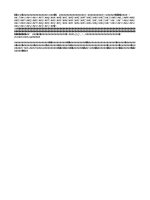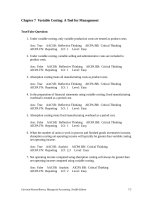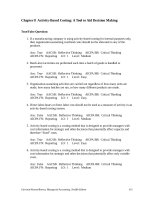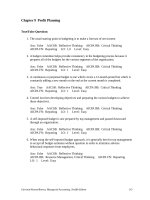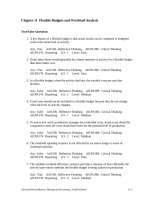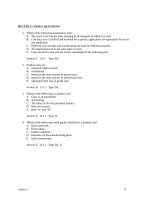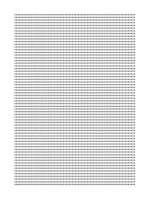Test bank managerial accounting by hilton 9e chapter02
Bạn đang xem bản rút gọn của tài liệu. Xem và tải ngay bản đầy đủ của tài liệu tại đây (124.3 KB, 32 trang )
MULTIPLE CHOICE QUESTIONS
1. Which of the following statements is true?
A. The word "cost" has the same meaning in all situations in which it is used.
B. Cost data, once classified and recorded for a specific application, are appropriate for use in
any application.
C. Different cost concepts and classifications are used for different purposes.
D. All organizations incur the same types of costs.
E. Costs incurred in one year are always meaningful in the following year.
Answer: C LO: 1 Type: RC
2. Product costs are:
A. expensed when incurred.
B. inventoried.
C. treated in the same manner as period costs.
D. treated in the same manner as advertising costs.
E. subtracted from cost of goods sold.
Answer: B LO: 2 Type: RC
3. Which of the following is a product cost?
A. Glass in an automobile.
B. Advertising.
C. The salary of the vice president-finance.
D. Rent on a factory.
E. Both "A" and "D."
Answer: E LO: 2 Type: N
4. Which of the following would not be classified as a product cost?
A. Direct materials.
B. Direct labor.
C. Indirect materials.
D. Insurance on the manufacturing plant.
E. Sales commissions.
Answer: E LO: 2 Type: RC, N
Chapter 2
17
5. The accounting records of Tacoma Company revealed the following costs: direct materials used,
$170,000; direct labor, $350,000; manufacturing overhead, $400,000; and selling and
administrative expenses, $220,000. Tacoma's product costs total:
A. $520,000.
B. $750,000.
C. $920,000.
D. $1,140,000.
E. some other amount.
Answer: C LO: 2 Type: A
6. Costs that are expensed when incurred are called:
A. product costs.
B. direct costs.
C. inventoriable costs.
D. period costs.
E. indirect costs.
Answer: D LO: 2 Type: RC
7. Which of the following is a period cost?
A. Direct material.
B. Advertising expense.
C. Depreciation on cars driven by a firm's president and treasurer.
D. Miscellaneous supplies used in production activities.
E. Both "B" and "C."
Answer: E LO: 2 Type: N
8. Which of the following is not a period cost?
A. Legal costs.
B. Public relations costs.
C. Sales commissions.
D. Wages of assembly-line workers.
E. The salary of a company's chief financial officer (CFO).
Answer: D LO: 2 Type: RC, N
9. The accounting records of Hill Corporation revealed the following selected costs: Sales
commissions, $40,000; plant supervision, $94,000; and administrative expenses, $185,000. Hill's
period costs total:
A. $40,000.
B. $94,000.
C. $185,000.
D. $225,000.
E. $319,000.
Answer: D LO: 2 Type: A
18
Hilton, Managerial Accounting, Seventh Edition
10. Which of the following entities would most likely have raw materials, work in process, and
finished goods?
A. Exxon Corporation.
B. Macy's Department Store.
C. Wendy's.
D. Southwest Airlines.
E. Columbia University.
Answer: A LO: 3 Type: N
11. Selling and administrative expenses would likely appear on the balance sheet of:
A. The Gap.
B. Texas Instruments.
C. Turner Broadcasting System.
D. all of the above firms.
E. none of the above firms.
Answer: E LO: 3 Type: N
12. Which of the following inventories would a discount retailer such as Wal-Mart report as an asset?
A. Raw materials.
B. Work in process.
C. Finished goods.
D. Merchandise inventory.
E. All of the above.
Answer: D LO: 3 Type: RC
13. Which of the following inventories would a company ordinarily hold for sale?
A. Raw materials.
B. Work in process.
C. Finished goods.
D. Raw materials and finished goods.
E. Work in process and finished goods.
Answer: C LO: 3 Type: RC
14. Zeno Corporation engages in mass customization and direct sales, the latter by accepting
customer orders over the Internet. As a result, Zeno:
A. would probably begin the manufacturing process upon receipt of a customer's order.
B. would typically have fairly low inventory levels for the amount of sales revenue generated.
C. would typically have fairly high inventory levels for the amount of sales revenue generated.
D. would likely find choices "A" and "B" to be applicable.
E. would likely find choices "A" and "C" to be applicable.
Answer: D LO: 4 Type: RC
Chapter 2
19
15. Companies that engage in mass customization:
A. tend to have a relatively low production volume.
B. tend to have a high production volume that involves highly standardized end-products.
C. tend to have a high production volume, many standardized components, and customerspecified combinations of components.
D. tend to have a high production volume, many unique components, and customer-specified
combinations of components.
E. could be typified by the refining operations of Shell Oil.
Answer: C LO: 4 Type: RC
16. Midwest Motors manufactures automobiles. Which of the following would not be classified as
direct materials by the company?
A. Sheet metal used in the automobile's body.
B. Tires.
C. Interior leather.
D. CD player.
E. Wheel lubricant.
Answer: E LO: 5 Type: N
17. Which of the following employees of a commercial printer/publisher would be classified as direct
labor?
A. Book binder.
B. Plant security guard.
C. Sales representative.
D. Plant supervisor.
E. Payroll supervisor.
Answer: A LO: 5 Type: N
18. Norwood Appliance produces washers and dryers in an assembly-line process. Labor costs
incurred during a recent period were: corporate executives, $100,000; assembly-line workers,
$80,000; security guards, $18,000; and plant supervisor, $30,000. The total of Norwood's direct
labor cost was:
A. $80,000.
B. $98,000.
C. $110,000.
D. $128,000.
E. $228,000.
Answer: A LO: 5 Type: A
20
Hilton, Managerial Accounting, Seventh Edition
19. Which of the following employees would not be classified as indirect labor?
A. Custodian.
B. Salesperson.
C. Assembler of wooden furniture.
D. Plant security guard.
E. Choices "B" and "C."
Answer: E LO: 5 Type: RC, N
20. Depreciation of factory equipment would be classified as:
A. operating cost.
B. "other" cost.
C. manufacturing overhead.
D. depreciation expense.
E. administrative cost.
Answer: C LO: 5 Type: RC
21. Which of the following costs is not a component of manufacturing overhead?
A. Indirect materials.
B. Factory utilities.
C. Factory equipment.
D. Indirect labor.
E. Property taxes on the manufacturing plant.
Answer: C LO: 5 Type: RC
22. The accounting records of Westcott Company revealed the following costs:
Factory utilities
Wages of assembly-line personnel
Customer entertainment
Indirect materials used
Depreciation on salespersons' cars
Production equipment rental costs
$ 35,000
170,000
45,000
19,000
51,000
110,000
Costs that would be considered in the calculation of manufacturing overhead total:
A. $164,000.
B. $215,000.
C. $385,000.
D. $430,000.
E. some other amount.
Answer: A LO: 5 Type: A
Chapter 2
21
23. Which of the following statements is (are) correct?
A. Overtime premiums should be treated as a component of manufacturing overhead.
B. Overtime premiums should be treated as a component of direct labor.
C. Idle time should be treated as a component of direct labor.
D. Idle time should be accounted for as a special type of loss.
E. Both "B" and "C" are correct.
Answer: A LO: 5 Type: RC
24. Conversion costs are:
A. direct material, direct labor, and manufacturing overhead.
B. direct material and direct labor.
C. direct labor and manufacturing overhead.
D. prime costs.
E. period costs.
Answer: C LO: 5 Type: RC
25. Prime costs are comprised of:
A. direct materials and manufacturing overhead.
B. direct labor and manufacturing overhead.
C. direct materials, direct labor, and manufacturing overhead.
D. direct materials and direct labor.
E. direct materials and indirect materials.
Answer: D LO: 5 Type: RC
26. Which of the following statements is true?
A. Product costs affect only the balance sheet.
B. Product costs affect only the income statement.
C. Period costs affect only the balance sheet.
D. Period costs affect both the balance sheet and the income statement.
E. Product costs eventually affect both the balance sheet and the income statement.
Answer: E LO: 6 Type: N
27. In a manufacturing company, the cost of goods completed during the period would include which
of the following elements?
A. Raw materials used.
B. Beginning finished goods inventory.
C. Marketing costs.
D. Depreciation of delivery trucks.
E. More than one of the above.
Answer: A LO: 6 Type: RC
22
Hilton, Managerial Accounting, Seventh Edition
28. Which of the following equations is used to calculate cost of goods sold during the period?
A. Beginning finished goods + cost of goods manufactured + ending finished goods.
B. Beginning finished goods - ending finished goods.
C. Beginning finished goods + cost of goods manufactured.
D. Beginning finished goods + cost of goods manufactured - ending finished goods.
E. Beginning finished goods + ending finished goods - cost of goods manufactured.
Answer: D LO: 6 Type: RC
29. Work-in-process inventory is composed of:
A. direct material and direct labor.
B. direct labor and manufacturing overhead.
C. direct material and manufacturing overhead.
D. direct material only.
E. direct material, direct labor, and manufacturing overhead.
Answer: E LO: 6 Type: RC
30. Fort Walton Industries began July with a finished-goods inventory of $48,000. The finishedgoods inventory at the end of July was $41,000 and the cost of goods sold during the month was
$125,000. The cost of goods manufactured during July was:
A. $77,000.
B. $84,000.
C. $118,000.
D. $132,000.
E. some other amount.
Answer: C LO: 6 Type: A
31. Kansas Plating Company reported a cost of goods manufactured of $260,000, with the firm's
year-end balance sheet revealing work in process and finished goods of $35,000 and $67,000,
respectively. If supplemental information disclosed raw materials used in production of $40,000,
direct labor of $70,000, and manufacturing overhead of $120,000, the company's beginning work
in process must have been:
A. $5,000.
B. $37,000.
C. $65,000.
D. $97,000.
E. some other amount.
Answer: C LO: 6 Type: A
Chapter 2
23
32. The accounting records of Bronco Company revealed the following information:
Raw materials used
Direct labor
Manufacturing overhead
Work-in-process inventory, 1/1
Finished-goods inventory, 1/1
Work-in-process inventory, 12/31
Finished-goods inventory, 12/31
$ 60,000
125,000
360,000
50,000
189,000
76,000
140,000
Bronco's cost of goods manufactured is:
A. $519,000.
B. $522,000.
C. $568,000.
D. $571,000.
E. some other amount.
Answer: A LO: 6 Type: A
33. The accounting records of Dolphin Company revealed the following information:
Total manufacturing costs
Work-in-process inventory, Jan. 1
Work-in-process inventory, Dec. 31
Finished-goods inventory, Jan. 1
Finished-goods inventory, Dec. 31
$530,000
56,000
78,000
146,000
123,000
Dolphin's cost of goods sold is:
A. $508,000.
B. $529,000.
C. $531,000.
D. $553,000.
E. some other amount.
Answer: C LO: 6 Type: A
34. For the year just ended, Cole Corporation's manufacturing costs (raw materials used, direct labor,
and manufacturing overhead) totaled $1,500,000. Beginning and ending work-in-process
inventories were $60,000 and $90,000, respectively. Cole's balance sheet also revealed respective
beginning and ending finished-goods inventories of $250,000 and $180,000. On the basis of this
information, how much would the company report as cost of goods manufactured (CGM) and
cost of goods sold (CGS)?
A. CGM, $1,430,000; CGS, $1,460,000.
B. CGM, $1,470,000; CGS, $1,540,000.
C. CGM, $1,530,000; CGS, $1,460,000.
D. CGM, $1,570,000; CGS, $1,540,000.
E. Some other amounts.
Answer: B LO: 6 Type: A
24
Hilton, Managerial Accounting, Seventh Edition
35. Leggio Industries reported the following data for the year just ended: sales revenue, $950,000;
cost of goods sold, $420,000; cost of goods manufactured, $330,000; and selling and
administrative expenses, $170,000. Leggio's gross margin would be:
A. $30,000.
B. $200,000.
C. $360,000.
D. $530,000.
E. $620,000.
Answer: D LO: 6 Type: A
36. Pumpkin Enterprises began operations on January 1, 20x1, with all of its activities conducted
from a single facility. The company's accountant concluded that the year's building depreciation
should be allocated as follows: selling activities, 20%; administrative activities, 35%; and
manufacturing activities, 45%. If Pumpkin sold 60% of 20x1 production during that year, what
percentage of the depreciation would appear (either directly or indirectly) on the 20x1 income
statement?
A. 27%.
B. 45%.
C. 55%.
D. 82%.
E. 100%.
Answer: D LO: 6 Type: A
37. An employee accidentally overstated the year's advertising expense by $50,000. Which of the
following correctly depicts the effect of this error?
A. Cost of goods manufactured will be overstated by $50,000.
B. Cost of goods sold will be overstated by $50,000.
C. Both cost of goods manufactured and cost of goods sold will be overstated by $50,000.
D. Cost of goods sold will be overstated by $50,000, and cost of goods manufactured will be
understated by $50,000.
E. None of the above.
Answer: E LO: 6 Type: A
38. Which of the following would likely be a cost driver for the amount of direct materials used?
A. The number of units sold.
B. The number of direct labor hours worked.
C. The number of machine hours worked.
D. The number of employees working in the factory.
E. The number of units produced.
Answer: E LO: 7 Type: N
Chapter 2
25
39. The choices below depict five costs of Benton Corporation and a possible driver for each cost.
Which of these choices likely contains an inappropriate cost driver?
A. Gasoline consumed; number of miles driven.
B. Manufacturing overhead incurred in a heavily automated facility; direct labor hours.
C. Sales commissions; gross sales revenue.
D. Building maintenance cost; building square footage.
E. Personnel department cost; number of employees.
Answer: B LO: 7 Type: N
40. Variable costs are those costs that:
A. vary inversely with changes in activity.
B. vary directly with changes in activity.
C. remain constant as activity changes.
D. decrease on a per-unit basis as activity increases.
E. increase on a per-unit basis as activity increases.
Answer: B LO: 8 Type: RC
41. As activity decreases, unit variable cost:
A. increases proportionately with activity.
B. decreases proportionately with activity.
C. remains constant.
D. increases by a fixed amount.
E. decreases by a fixed amount.
Answer: C LO: 8 Type: RC
42. Which of the following is not an example of a variable cost?
A. Straight-line depreciation on a machine that has a five-year service life.
B. Wages of manufacturing workers whose pay is based on hours worked.
C. Tires used in the production of tractors.
D. Aluminum used to make patio furniture.
E. Commissions paid to sales personnel.
Answer: A LO: 8 Type: N
43. Fixed costs are those costs that:
A. vary directly with changes in activity.
B. vary inversely with changes in activity.
C. remain constant on a per-unit basis.
D. increase on a per-unit basis as activity increases.
E. remain constant as activity changes.
Answer: E LO: 8 Type: RC
26
Hilton, Managerial Accounting, Seventh Edition
44. The fixed cost per unit:
A. will increase as activity increases.
B. will increase as activity decreases.
C. will decrease as activity increases.
D. will remain constant.
E. will exhibit the behavior described in choices "B" and "C."
Answer: E LO: 8 Type: N
45. Which of the following is an example of a fixed cost?
A. Paper used in the manufacture of textbooks.
B. Property taxes paid by a firm to the City of Los Angeles.
C. The wages of part-time workers who are paid $8 per hour.
D. Gasoline consumed by salespersons' cars.
E. Surgical supplies used in a hospital's operating room.
Answer: B LO: 8 Type: N
46. The variable costs per unit are $4 when a company produces 10,000 units of product. What are
the variable costs per unit when 8,000 units are produced?
A. $4.00.
B. $4.50.
C. $5.00.
D. $5.50.
E. Some other amount.
Answer: A LO: 8 Type: A
47. The fixed costs per unit are $10 when a company produces 10,000 units of product. What are the
fixed costs per unit when 12,500 units are produced?
A. $4.
B. $6.
C. $8.
D. $10.
E. Some other amount.
Answer: C LO: 8 Type: A
48. Total costs are $120,000 when 10,000 units are produced; of this amount, variable costs are
$48,000. What are the total costs when 12,000 units are produced?
A. $57,600.
B. $72,000.
C. $120,000.
D. $129,600.
E. $144,000.
Answer: D LO: 8 Type: A
Chapter 2
27
49. Baxter Company, which pays a 10% commission to its salespeople, reported sales revenues of
$210,000 for the period just ended. If fixed and variable sales expenses totaled $56,000, what
would these expenses total at sales of $168,000?
A. $16,800.
B. $35,000.
C. $44,800.
D. $51,800.
E. Some other amount.
Answer: D LO: 8 Type: A
50. Which of the following would not be characterized as a cost object?
A. An automobile manufactured by General Motors.
B. The New York Fire Department.
C. A Burger King restaurant located in Cleveland, Ohio.
D. A Delta Airlines flight from Atlanta to Miami.
E. All of the above are examples of cost objects.
Answer: E LO: 9 Type: N
51. Costs that can be easily traced to a specific department are called:
A. direct costs.
B. indirect costs.
C. product costs.
D. manufacturing costs.
E. processing costs.
Answer: A LO: 9 Type: RC
52. Which of the following would not be considered a direct cost with respect to the service
department of a new car dealership?
A. Wages of repair techniques.
B. Property taxes paid by the dealership.
C. Repair parts consumed.
D. Salary of the department manager.
E. Depreciation on new equipment used to analyze engine problems.
Answer: B LO: 9 Type: N
53. Indirect costs:
A. can be traced to a cost object.
B. cannot be traced to a particular cost object.
C. are not important.
D. are always variable costs.
E. may be indirect with respect to Disney World but direct with respect to one its major
components, Epcot Center.
Answer: B LO: 9 Type: RC, N
28
Hilton, Managerial Accounting, Seventh Edition
54. The salary that is sacrificed by a college student who pursues a degree full time is a(n):
A. sunk cost.
B. out-of-pocket cost.
C. opportunity cost.
D. differential cost.
E. marginal cost.
Answer: C LO: 10 Type: N
55. The tuition that will be paid next semester by a college student who pursues a degree is a(n):
A. sunk cost.
B. out-of-pocket cost.
C. indirect cost.
D. average cost.
E. marginal cost.
Answer: B LO: 10 Type: N
56. Which of the following costs should be ignored when choosing among alternatives?
A. Opportunity costs.
B. Sunk costs.
C. Out-of-pocket costs.
D. Differential costs.
E. None of the above.
Answer: B LO: 10 Type: RC
57. If the total cost of alternative A is $50,000 and the total cost of alternative B is $34,000, then
$16,000 is termed the:
A. opportunity cost.
B. average cost.
C. sunk cost.
D. out-of-pocket cost.
E. differential cost.
Answer: E LO: 10 Type: N
Use the following to answer questions 58-59:
Wee Care is a nursery school for pre-kindergarten children. The school has determined that the following
biweekly revenues and costs occur at different levels of enrollment:
Number of
Students Enrolled
10
15
16
20
21
Chapter 2
Total Revenue
$3,000
4,500
4,800
6,000
6,300
Total Costs
$2,100
2,700
2,800
3,200
3,255
29
30
Hilton, Managerial Accounting, Seventh Edition
58. The marginal cost when the twenty-first student enrolls in the school is:
A. $55.
B. $155.
C. $300.
D. $3,045.
E. $3,255.
Answer: A LO: 10 Type: A
59. The average cost per student when 16 students enroll in the school is:
A. $100.
B. $125.
C. $175.
D. $300.
E. $400.
Answer: C LO: 10 Type: A
60. The costs that follow all have applicability for a manufacturing enterprise. Which of the choices
listed correctly denotes the costs’ applicability for a service provider?
Period Cost
Uncontrollable Cost
Opportunity Cost
Applicable
Applicable
Not applicable
Applicable
Not applicable
Applicable
Applicable
Applicable
Applicable
Not applicable
Applicable
Applicable
Not applicable
Applicable
Not applicable
Answer: C LO: 10 Type: RC
EXERCISES
Cost Concepts; Different Types of Entities
61. Consider the three firms that follow: (1) Continental Airlines, (2) BMW, and (3) Target. These
firms, examples of service providers, manufacturers, and merchandisers, tend to have different
characteristics with respect to costs and financial-statement disclosures.
Required:
Determine which of the preceding firms (1, 2, and/or 3) would likely:
A. Disclose operating expenses on the income statement.
B. Have product costs.
C. Have period costs.
D. Disclose cost of cost good sold on the income statement.
E. Have no meaningful investment in inventory.
F. Maintain raw-material, work-in-process, and finished-goods inventories.
G. Have variable and fixed costs.
LO: 2, 3, 8 Type: N
Chapter 2
31
Answer:
A. 1, 2, 3
B. 2, 3
C. 1, 2, 3
D. 2, 3
E. 1
F. 2
G. 1, 2, 3
Content of Financial Statements and Reports
62. Consider the following cost items:
1.
2.
3.
4.
5.
6.
7.
8.
9.
Sales commissions earned by a company's sales force.
Raw materials purchased during the period.
Current year's depreciation on a firm's manufacturing facilities.
Year-end completed production of a carpet manufacturer.
The cost of products sold to customers of an apparel store.
Wages earned by machine operators in a manufacturing plant.
Income taxes incurred by an airline.
Marketing costs of an electronics manufacturer.
Indirect labor costs incurred by a manufacturer of office equipment.
Required:
A. Evaluate the costs just cited and determine whether the associated dollar amounts would be
found on the firm's balance sheet, income statement, or schedule of cost of goods
manufactured.
B. What major asset will normally be insignificant for service enterprises and relatively
substantial for retailers, wholesalers, and manufacturers? Briefly discuss.
C. Briefly explain the similarity and difference between the merchandise inventory of a retailer
and the finished-goods inventory of a manufacturer.
LO: 3, 6 Type: N
Answer:
A. 1. Income statement
2. Schedule of cost of goods manufactured
3. Schedule of cost of goods manufactured
4. Balance sheet
5. Income statement
6. Schedule of cost of goods manufactured
7. Income statement
8. Income statement
9. Schedule of cost of goods manufactured
32
B.
The asset that differs among these businesses is inventory. Service businesses
typically carry no (or very little) inventory. Retailers and wholesalers normally stock
considerable inventory. Manufacturers also carry significant inventories, typically subdivided
in three categories: raw materials, work in process, and finished goods.
C.
The similarity: Both inventories are carried for sale by the respective businesses. The
Hilton, Managerial Accounting, Seventh Edition
difference: Retailers purchase merchandise inventory; in contrast, manufacturing firms
produce their goods.
Identification of Product Costs and Period Costs, Cost Behavior
63. Eastside Manufacturing produces small electric engines. Identify the following costs as direct
materials (DM), direct labor (DL), manufacturing overhead (MOH), or a period cost (PC). Also
indicate whether the cost is variable (V) or fixed (F) with respect to behavior.
A.
B.
C.
D.
E.
F.
G.
H.
I.
Commissions paid to salespeople
Straight-line depreciation on the factory building
Salary of the plant supervisor
Wages of the assembly-line workers
Machine lubricant used in production activities
Engine casings used in production activities
Advertising placed in trade journals
Lease payments for the president's automobile
Property taxes paid on the factory facilities
LO: 2, 5, 8 Type: N
Answer:
A. PC, V
B. MOH, F
C. MOH, F
D. DL, V
E. MOH, V
F. DM, V
G. PC, F
H. PC, F
I. MOH, F
Chapter 2
33
Identification of Product Costs and Period Costs, Cost Behavior
64. Consider the following items:
A.
B.
C.
D.
E.
F.
G.
H.
I.
Tomatoes used in the manufacture of Heinz ketchup
Administrative salaries of executives employed by Southwest Airlines
Wages of assembly-line workers at a Ford plant
Marketing expenditures of the Los Angeles Dodgers baseball club
Commissions paid to Coca-Cola's salespeople
Straight-line depreciation on manufacturing equipment owned by Dell Computer
Shipping charges incurred by Office Depot on out-going orders
Speakers used in Sony home-theater systems
Insurance costs related to a Mary Kay Cosmetics' manufacturing plant
Required:
Complete the table that follows and classify each of the costs listed as (1) a product or period cost
and (2) a variable or fixed cost by placing an "X" in the appropriate column.
Item
A
B
C
D
E
F
G
H
I
Product or Period Cost
Product
Period
Variable or Fixed Cost
Variable
Fixed
LO: 2, 5, 8 Type: N
Answer:
Item
A
B
C
D
E
F
G
H
I
34
Product or Period Cost
Product
Period
X
X
X
X
X
X
X
X
X
Variable or Fixed Cost
Variable
Fixed
X
X
X
X
X
X
X
X
X
Hilton, Managerial Accounting, Seventh Edition
Identification of Various Cost Concepts
65. The following selected costs were extracted from the accounting records of Los Angeles
Machining (LAM):
1.
2.
3.
4.
5.
6.
7.
8.
9.
Direct materials used in production
Wages of machine operators
Factory utilities
Sales commissions
Salary of LAM's president
Factory depreciation
Wages of plant security guards
Uncollectible accounts expense
Machine lubricant used in production
Required:
By the use of numbers, identify the costs that would be used to calculate:
A. cost of goods manufactured.
B. manufacturing overhead.
C. total period costs.
D. total conversion costs.
E. total direct costs of LAM's credit and collections department.
F. LAM's inventory valuation.
LO: 2, 5, 6, 9 Type: N
Answer:
A. 1, 2, 3, 6, 7, 9
B. 3, 6, 7, 9
C. 4, 5, 8
D. 2, 3, 6, 7, 9
E. 8
F. 1, 2, 3, 6, 7, 9
Chapter 2
35
Cost of Goods Manufactured and Cost of Goods Sold
66. Panama Manufacturing had the following data for the period just ended:
Work in process, Jan. 1
Work in process, Dec. 31
Finished goods, Jan. 1
Finished goods, Dec. 31
Direct materials used
Direct labor
Factory depreciation
Sales
Advertising expense
Factory utilities
Indirect materials
Indirect labor
$ 21,000
40,000
70,000
61,000
126,000
260,000
80,000
945,000
52,000
27,000
19,000
35,000
Required:
A. Calculate Panama's cost of goods manufactured.
B. Calculate Panama's cost of goods sold.
LO: 6 Type: A
Answer:
A. Direct materials used
Direct labor
Manufacturing overhead:
Factory depreciation
Factory utilities
Indirect materials
Indirect labor
Total manufacturing costs
Add: Work in process, Jan. 1
36
$126,000
260,000
Deduct: Work in process, Dec. 31
Cost of goods manufactured
80,000
27,000
19,000
35,000
$547,000
21,000
$568,000
40,000
$528,000
B. Finished goods, Jan. 1
Add: Cost of goods manufactured
Goods available for sale
Deduct: Finished goods, Dec. 31
Cost of goods sold
$ 70,000
528,000
$598,000
61,000
$537,000
Hilton, Managerial Accounting, Seventh Edition
Income-Related Computations
67. Hampton Company had the following inventory balances at the beginning and end of the year:
Raw material
Work in process
Finished goods
January 1
$ 50,000
130,000
280,000
December 31
$ 35,000
170,000
255,000
During the year, the company purchased $100,000 of raw material and spent $340,000 on direct
labor. Other data: manufacturing overhead incurred, $450,000; sales, $1,560,000; selling and
administrative expenses, $90,000; income tax rate, 30%.
Required:
A. Calculate cost of goods manufactured.
B. Calculate cost of goods sold.
C. Determine Hampton's net income.
LO: 6 Type: A
Answer:
A. Direct materials used:
Raw materials, Jan. 1
Add: Purchases
Raw materials available for use
Deduct: Raw material, Dec. 31
Raw material used
Direct labor
Manufacturing overhead
Total manufacturing costs
Add: Work in process, Jan. 1
$ 50,000
100,000
$150,000
35,000
Deduct: Work in process, Dec. 31
Cost of goods manufactured
$ 115,000
340,000
450,000
$ 905,000
130,000
$1,035,000
170,000
$ 865,000
B.
Finished goods, Jan. 1
Add: Cost of goods manufactured
Cost of goods available for sale
Deduct: Finished goods, Dec. 31
Cost of goods sold
$ 280,000
865,000
$1,145,000
255,000
$ 890,000
C.
Sales revenue
Less: Cost of goods sold
Gross margin
Less: Selling and administrative expenses
Income before taxes
Income tax expense ($580,000 x 30%)
Net income
$1,560,000
890,000
$ 670,000
90,000
$ 580,000
174,000
$ 406,000
Chapter 2
37
Elements of Financial Statements
68. The following selected information was extracted from the 20x3 accounting records of Miami
Products:
Raw materials used
Direct labor
Indirect labor
Selling and administrative salaries
Building depreciation*
Other selling and administrative expenses
Other factory costs
$284,000
178,000
35,000
250,000
330,000
80,000
620,000
*Seventy percent of the company's building was devoted to production activities; the
remaining 30% was used for selling and administrative functions.
Miami's beginning and ending work-in-process inventories amounted to $306,000 and $245,000,
respectively. The company's beginning and ending finished-goods inventories were $450,000 and
$440,000, respectively.
Required:
A. Calculate Miami's manufacturing overhead for the year.
B. Calculate Miami's cost of goods manufactured.
C. Compute the company's cost of goods sold.
LO: 5, 6 Type: A
Answer:
A. Indirect labor
Building depreciation ($330,000 x 70%)
Other factory costs
Total
B.
C.
38
Raw material used
Direct labor
Manufacturing overhead
Total manufacturing costs
Add: Work in process, beg.
$
35,000
231,000
620,000
$ 886,000
Deduct: Work in process, end.
Cost of goods manufactured
$ 284,000
178,000
886,000
$1,348,000
306,000
$1,654,000
245,000
$1,409,000
Finished goods, beg.
Add: Cost of goods manufactured
Cost of goods available for sale
Deduct: Finished goods, end.
Cost of goods sold
$ 450,000
1,409,000
$1,859,000
440,000
$1,419,000
Hilton, Managerial Accounting, Seventh Edition
Income and Financial-Schedule Calculations: Working Backwards
69. The selected amounts that follow were taken from Kentucky Corporation's accounting records:
Raw material used
Direct labor
Total manufacturing costs
Work-in-process inventory, 1/1
Cost of goods manufactured
Cost of goods available for sale
Finished-goods inventory, 12/31
Sales revenue
Selling and administrative expenses
Income tax expense
$ 27,000
35,000
104,000
19,000
100,000
175,000
60,000
300,000
125,000
18,000
Required:
Compute the following:
A. Manufacturing overhead.
B. Work-in-process inventory, 12/31.
C. Finished-goods inventory, 1/1.
D. Cost of goods sold.
E. Gross margin.
F. Net income.
LO: 6 Type: A
Answer:
A. Total manufacturing costs
Less: Raw material used
Direct labor
Manufacturing overhead
B.
62,000
$ 42,000
Less: Cost of goods manufactured
Work-in-process inventory, 12/31
$104,000
19,000
$123,000
100,000
$ 23,000
C.
Cost of goods available for sale
Less: Cost of goods manufactured
Finished-goods inventory, 1/1
$175,000
100,000
$ 75,000
D.
Cost of goods available for sale
Less: Finished-goods inventory, 12/31
Cost of goods sold
$175,000
60,000
$115,000
E.
Sales revenue
Less: Cost of goods sold
Gross margin
$300,000
115,000
$185,000
Chapter 2
Total manufacturing costs
Add: Work-in-process inventory, 1/1
$104,000
$27,000
35,000
39
F.
Gross margin
Less: Selling and administrative expenses
Income tax expense
Net income
$185,000
$125,000
18,000
143,000
$ 42,000
Flow of Costs, Missing Values
70. The Morton Company recorded the following transactions for February 20x1:
Purchases
Beginning inventory
Ending inventory
Direct materials used
Direct labor
Manufacturing overhead
(includes indirect materials used
of $10,000)
Transferred to finished goods
Cost of goods sold
Materials
$100,000
18,000
A
Work in Process
Finished Goods
$ 8,000
20,000
90,000
B
$ E
30,000
115,000
C
D
Sales were $560,000, with sales prices determined by adding a 40% markup to the firm's
manufacturing cost. The total cost of direct materials used, direct labor, and manufacturing
overhead during the month was $285,000.
Required:
Calculate the missing values.
LO: 6 Type: A
40
Answer:
Item A:
Beginning materials
Add: Purchases
Less: Direct materials used
Less: Indirect materials used
Ending materials
$ 18,000
100,000
(90,000)
(10,000)
$ 18,000
Item B:
Total production costs
Less: Direct materials used
Less: Manufacturing overhead
Direct labor
$ 285,000
(90,000)
(115,000)
$ 80,000
Item C:
Beginning work in process
Add: Total production costs
Less: Ending work in process
$ 8,000
285,000
(20,000)
Hilton, Managerial Accounting, Seventh Edition
Transferred to finished goods
$273,000
Item D:
Sales
Divided by rate
Cost of goods sold
$560,000
÷ 140%
$400,000
Item E:
Ending finished goods
Add: Cost of goods sold
Less: Transferred to finished goods
Beginning finished goods
$ 30,000
400,000
(273,000)
$157,000
Fixed and Variable Cost Behavior
71. Mighty Muffler, Inc., operates an automobile service facility. The table below shows the cost
incurred during a month when 600 mufflers were replaced.
Number of Muffler Replacements
500
600
700
Total costs:
Fixed costs
Variable costs
Total costs
A
B
E
$ 8,400
6,000
$14,400
C
D
F
Cost per muffler replacement:
Fixed cost
Variable cost
Total cost per muffler replacement
G
J
M
H
K
N
I
L
O
Required:
Fill in the missing amounts, labeled A through O, in the table.
LO: 8 Type: A
Chapter 2
41
